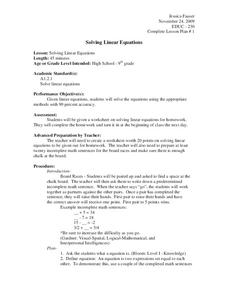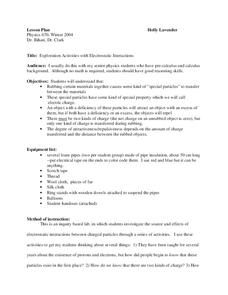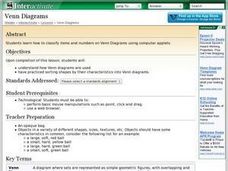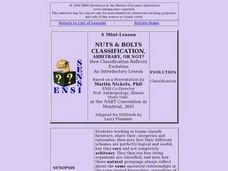Curated OER
Solving Linear Equations
Study linear equations with this algebra lesson. Middle schoolers solve linear equations using the appropriate properties and create their own equations for each other to solve.
Curated OER
Triangle Inequality
Students discover that the sum of the lengths of any two sides of a triangle must be greater than the third side. They are shown how a triangle is formed using three strips such as that the triangle is seen inside the strips.
Curated OER
Property Lists for Quadrilaterals
Young scholars establish classifications of shapes by various properties (angles, sides, etc.). They introduce the important properties of common shapes. Students develop an awareness of the wide variety of ways the 2-D shapes can be alike.
Illustrative Mathematics
Zeroes and factorization of a quadratic polynomial I
This activity uses the division algorithm and the definition of a zero/root of a function to guide your class to see the relationship between zeros and factors of a general quadratic, which can later be generalized to the Remainder...
Improving Measurement and Geometry in Elementary Schools
The Sum of the Interior Angles of a Polygon
Junior geometers discover that polygons can be decomposed into triangles and that the number of triangles can be determined by a rule. Note that the Geometer’s Sketchpad® software is required to carry out all components of this...
Illustrative Mathematics
Comparing Rational and Irrational Number
Algebra learners must know how to use rational numbers to approximate irrationals. This resource asks participants to decide which number is larger without using a calculator. It makes a great exercise to use as a five-minute transition...
Ohio State University
Exploration Activities with Electrostatic Interactions
Step out of the 21st century and discover protons and electrons through observation. Using common materials, participants continually adjust their explanation of charges. The final assessment requires pupils to design their own...
Curated OER
Probably Pistachio
First graders practice making logical predictions from information they are given.
Curated OER
Venn Diagram Lesson Plan
Students use Venn diagrams in order to classify different objects and numbers. They then use "Venn Diagram Shape sorter" applets on the computer.
Curated OER
Space Crossing
Learners critically follow a chain of reasoning to devise a decent problem solving technique to be applied to a reasonable problem. They also examine how to use logical arguments.
Curated OER
Multiplication Algorithm (1)
Third graders in a 3rd grade math class make connections from prior instruction and mastery to solve problems in new learning situations. Using logical thinking and prior knowledge to solve current math problems is the focus of this...
Curated OER
Getting to the Bottom of the Pyramids
Students work together to develop logical arguments about pyramids and chain letters. They share their ideas with other groups and create a diagram showing the breakdown. They discuss the results.
Curated OER
Venn Diagram with Blocks
Fifth graders classify blocks according to their attributes. In this math lesson, 5th graders will identify attributes of blocks, sort them, then form the groups into a Venn Diagram, and write ratios using the attributes.
Curated OER
Missing Square
In this missing square worksheet, students find the missing square amongst a group of numbers with the number that logically belongs there. Students complete 1 problem.
Curated OER
Who Grows Cabbage?
Learners use logic to solve the puzzle about vegetable farming. In this logical thinking lesson, students use the game board of various vegetable categories to define which farmer grows cabbage. Learners use the clues to help them...
Curated OER
Mathematical Proofs
Students explore the nature of mathematical proofs and mathematical inquiry. They complete the activity "Using the Pythagorean Theorem". They read selected articles and participate in class discussions.
Curated OER
Bagels, Pico, Fermi
In this number game, 7th graders work as a class to figure out a three-digit mystery number. Students use logic and the process of elimination to find the answer. It is a great time filler when there are 10 minutes left in class, and...
Curated OER
Name that Number
First graders state numbers from 1 to 100. In this name that number instructional activity, 1st graders must identify and state 10 random numbers given on a worksheet.
Curated OER
Patterns
Second graders create an ABAB pattern with their name. In this early elementary math lesson plan, 2nd graders first model their names in an ABAB pattern with unifix cubes. They then recreate the pattern using letter stamps on KidPix.
Curated OER
Using Trigonometry
Fifth graders explore the use of trigonometry to find unknown sides and angles in right-angled triangles, taking the concepts that were developed in the previous unit and looking at different ways of practicing the new skills. Students...
Curated OER
Who Plays What?
Ninth graders divide in pairs 3 cards with the words possible, impossible and certain on them. Ask questions of the class and get the students to hold up the word that describes the event (for example) Tomorrow it will snow. You have...
Curated OER
My Son is Naughty
Students find factors of numbers; work systematically; and use logic to explain away certain possible number combinations. They then devise and use problem solving strategies to explore situations mathematically.
Curated OER
Divided We Stand
Students figure out how to arrange seating in a concert hall given specific requirements. They better explain how dividing can allow us to arrive at mathematical solutions quickly and logically.
Curated OER
Nuts & Bolts: is Classification, Arbitrary, Or Not?
Students, in groups, classify furniture, share their categories and rationales, then note how their different schemes vary, perfectly logical and useful, but completely arbitrary.

























